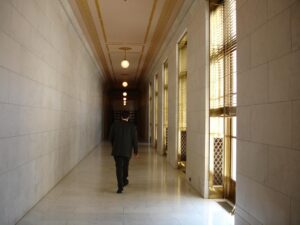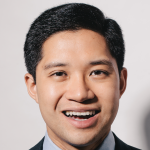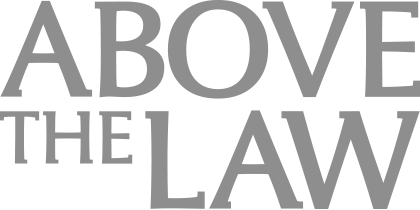Supreme Court Clerk Hiring Watch: The Complete Clerk Roster For October Term 2018
What's happening to the "orphaned" law clerks who were hired by Justice Kennedy before he announced his retirement?

At the U.S. Supreme Court (photo by David Lat).
While we wait for the Supreme Court confirmation hearings of Judge Brett Kavanaugh of the D.C. Circuit to get underway, let’s turn to a related topic that we haven’t covered since May: Supreme Court clerk hiring.
We now have the full roster of SCOTUS clerks for October Term 2018 — and not a moment too soon, since the clerks are now changing over and the official start of the Term is just a few short weeks away. Some of you have already seen these names on Twitter — follow @SCOTUSambitions, which offers closer to real-time clerk hiring news — but this post brings them together all in one place.

How Thomson Reuters Supercharged CoCounsel With Gen AI Advances

Before we get to the names, though, let’s begin with our customary roundup of clerk-related news:
1. The “orphaned” Kennedy clerks. Inquiring minds want to know: what’s happening to the four clerks that Justice Kennedy hired for OT 2018? In a story about them a few weeks ago, Tony Mauro predicted that “if court tradition holds, the four won’t be jobless for long” — and that prediction has come to pass.
For the upcoming Term, Aimee Brown will work in the chambers of Justice Samuel A. Alito, Alex Kazam will work in the chambers of Justice Neil M. Gorsuch, and Conrad Scott will work in the chambers of Justice Ruth Bader Ginsburg. The only “orphaned” clerk is Clayton Kozinski, but as a former Kavanaugh clerk, Clayton could end up clerking for a Justice Kavanaugh at the Court. [UPDATE (8/3/2018, 12:44 a.m.): Clayton Kozinski will clerk for Justice Kennedy in OT 2019, so he is also not an “orphan.” The list of OT 2019 clerks appearing below has been updated to reflect this.]
As for Sarah Sloan, the clerk to retired Justice John Paul Stevens who was slated to work as a fifth clerk in Justice Kennedy’s chambers, she will be going to work in the chambers of Justice Elena Kagan. So it seems that SCOTUS will be very well staffed for the upcoming Term.
Sponsored

Legal Contract Review in Under 10 Minutes? Here’s How

Curbing Client And Talent Loss With Productivity Tech

Data Privacy And Security With Gen AI Models

Legal Contract Review in Under 10 Minutes? Here’s How
(A caveat: the arrangements for the Kennedy clerks are not completely finalized and could change between now and the official start of the Term. The Court has not yet released its official list of October Term 2018 law clerks, so nothing has been set in stone. We will update this post if and when we receive new or different information about the fate of the AMK clerks.)
Here’s some speculation on my part. Why did Justice Kennedy make his retirement effective July 31 — after the end of the Court’s Term, and when nothing much is happening at One First Street? As it turns out, SCOTUS clerks turn over during the month of July. By remaining an “active” justice for the month of July, Justice Kennedy presumably entitled himself to the full complement of four clerks — i.e., four budget lines for his clerk staff. So this shrewd move on AMK’s part protected his hires from unemployment (or from having to be squeezed into a colleague’s future clerk class), since the money for their salaries was budgeted in advance.
Will Justice Kennedy have one more clerk who will work for him as a retired justice in October Term 2018? Clerks to retired justices help out their bosses on various projects, such as speeches and books and cases the justice hears in circuit courts, and these clerks also get farmed out to active justices to work on merits cases. It’s not clear whether Justice Kennedy will have a fourth clerk or whether he will receive such assistance from his three hires already at One First Street (Brown, Kazam, and Scott). If you have information to share on this score, please email me (subject line “SCOTUS Clerk Hiring”).
UPDATE (8/6/2018, 12:23 p.m.): We’ve been informed that retired Justice Kennedy will receive any support he requires from his three hires already at the Court (i.e., no fourth clerk).
UPDATE (8/8/2018, 5 p.m.): Tony Mauro has more information in an extremely interesting update over at the National Law Journal. He points out that this Term will likely see a record number of clerks at the Court (41), thanks to the Kennedy hires who have been detailed to other justices’ chambers. He also covers the diversity statistics, noting that 17 of the 41 clerks are women. That’s 45 percent, much higher than the average of 34 percent since 2005. Finally, he looks at the fates of the clerks who were “orphaned” by Justice Brennan’s sudden retirement in 1990 — two of whom wound up clerking for the Court anyway, and two of whom did not.
Sponsored

How Thomson Reuters Supercharged CoCounsel With Gen AI Advances


Tackling Deposition Anxiety: How AI Is Changing The Way Lawyers Do Depositions
2. SCOTUS Clerkship Bonuses. The signing bonuses that law firms pay to woo Supreme Court clerks just keep on heading higher. Considering the recent pay raises and summer bonuses for “regular” Biglaw associates, this isn’t shocking — but keep in mind that SCOTUS clerks will benefit from the raises too, since they generally get paid base salaries that reflect the seniority level reflected in their law school graduation year.
Or maybe it is shocking, considering how huge the SCOTUS clerk bonuses already were? When we last checked in, the going rate was $350,000, brought to market by the powerhouse litigation boutique of Wilkinson Walsh + Eskovitz and subsequently matched by everyone else (an increase from $330,000). But now we’re hearing that the bonuses are still climbing.
Many firms are still at $350K, but upon information and belief, at least six firms are offering $400,000, to at least some of their SCOTUS clerk recruits: Jones Day, Kirkland & Ellis, Orrick, Paul Weiss, Skadden Arps, and Susman Godfrey. In addition, some or all of these firms require just a one-year commitment to receive the full $400K (and some of them had a one-year policy last year too). This matters because, at many other firms, a former SCOTUS clerk must stick around for two years to get the full bonus, giving up some prorated portion of the bonus for leaving early.
3. The Law Clerk Hiring Plan. This isn’t about SCOTUS clerk hiring specifically, but it’s quite relevant because it affects feeder-judge hiring. The new and improved Law Clerk Hiring Plan, announced in March by four chief judges of prominent circuit courts, continues to pick up Supreme supporters.
In June, Justice Sonia Sotomayor announced that she “will pay close attention” to who’s adhering to the Plan and who is not — and “react accordingly” when it comes to hiring. She joins Justices Stephen Breyer, Ruth Bader Ginsburg and Elena Kagan in supporting the Plan, meaning that the entire “liberal” wing of the Court is now on record as pro-Plan. So I’d expect the Plan, at least in its first few years, to get decent traction, especially among law students who aspire to clerk for one of the liberal justices — and the feeder judges who send clerks to the left wing of the Court. (If you’re interested in overall trends in law clerk hiring, check out this interesting report from Professor Derek Muller, Federal Judicial Clerkship Report of Recent Law School Graduates – 2018 Edition.)
Moving on, let’s turn to color commentary on the latest hires:
1. Feeder schools. Supreme Court clerks continue to come from a handful of elite schools. For OT 2018, there are 37 clerks (counting the three farmed-out AMK clerks, but not Clayton Kozinski). They come from just 14 schools — and three schools, the “HYS” trinity of Harvard, Stanford, and Yale, produced 25 out of 37 clerks (68 percent). Yale leads the way with 12 clerks, Harvard has nine, and Stanford has four. Only one other school, Chicago, has more than one (two clerks total).
2. Feeder judges. There’s much more diversity on the feeder judge front, but that’s largely a function of how many clerks do two (or more) clerkships before arriving at SCOTUS. The 37 clerks for OT 2018 come from 41 different lower-court judges.
The judges with more than one clerk at the Court for the upcoming Term are Judges Kavanaugh (6), Griffith (3), Srinivasan (3), Tatel (3), Feinerman (3), Garland (2), Katsas (2), Pryor (2), Oetken (2), and Sullivan (2). Out of those ten judges, a whopping six sit on the Most Holy D.C. Circuit: Judges Kavanaugh, Griffith, Srinivasan, Tatel, Garland, and Katsas. Three are district judges: Judges Feinerman (N.D. Ill.), Oetken (S.D.N.Y.), and Sullivan (S.D.N.Y., but on his way to the Second Circuit). [UPDATE (8/3/2018, 12:44 a.m.): This paragraph has been edited to correct the number of Kavanaugh clerks (six rather than five), to correct the number of Feinerman clerks (three rather than two), and to add Judge Katsas (with two clerks at the Court this Term).]
In terms of feeders of the future, and looking at both the OT 2018 and OT 2019 lists, note the feeder-judge debuts of Judges Elrod (5th Cir.), Hamilton (7th Cir.), Hardiman (3d Cir.), Tymkovich (10th Cir.), Willett (5th Cir.), Chhabria (N.D. Cal.), Friedrich (D.D.C.), Moody (M.D. Fl.), and Cuéllar (Cal.). Going forward, I’d be curious to see if we see more feeding from Judge Hardiman, who raised his profile as a two-time SCOTUS finalist, and Judge Willett, who raised his profile through tweeting (@JusticeWillett, reflecting his former position as a justice of the Texas Supreme Court; alas, since joining the Fifth Circuit, his Twitter feed has gone silent).
Although they’ve sent clerks to SCOTUS prior to OT 2018, so they don’t count as “debut” feeder judges, I’d also keep an eye on Judges Barron (1st Cir.), Ikuta (9th Cir.), Moss (D.D.C.), and Brinkema (E.D. Va.). All except Judge Brinkema clerked for the Court themselves, which is increasingly common among feeder judges.
3. Feeder firms. It’s quite common these days for clerks to arrive at SCOTUS from private practice, given the varied paths taken to reach the Court nowadays (a departure from the old-fashioned “law school to feeder judge to SCOTUS” path). I’ve written before about so-called “feeder firms,” places like Williams & Connolly and Gibson Dunn that excel at minting SCOTUS clerks.
To this list, add Munger Tolles. Its California offices are already popular destinations for SCOTUS clerks who go west post-clerkship, and now its D.C. office — which is less than three years old, and has only a dozen or so lawyers — is sending two associates, Yale Law School grads Celia Choy and Dahlia Mignouna, to Justice Breyer for OT 2019.
Former U.S .Solicitor General Donald Verrilli Jr., one of the founding partners of MTO’s Washington outpost, described Choy and Mignouna to Tony Mauro as “brilliant lawyers” who also reflect the values of “diversity and inclusiveness and equity” that are crucial to the office. Choy is an Asian-American woman and Mignouna is an African-American woman, which means they fit right in at Munger D.C. — more than half of its 12 lawyers are women, and a third are minorities.

David Casazza (via Claremont Institute)
4. Mr. Irrelevant. Each year — consistent with our little tradition here at ATL, inspired by the NFL draft’s Mr. Irrelevant — we give extra publicity to the last SCOTUS clerk whose hiring we find out about. This year, Mr. Irrelevant is David Casazza. Congratulations, David!
Casazza is a 2015 graduate of Harvard Law School and a former law clerk to Judge Jennifer Elrod of the Fifth Circuit (who is, as discussed above, one to watch as a future feeder judge). As noted on the website of the Claremont Institute, which awarded him a John Marshall Fellowship — Claremont fellowships are not uncommon among SCOTUS clerks, especially the conservative ones — David has an A.B. in History from Princeton, an M.A. in History from Johns Hopkins, and a J.D. from Harvard Law School (magna cum laude, natch). At HLS, he served as executive vice president of the Federalist Society and managing editor of the Harvard Journal of Law & Public Policy. (That’s HLS’s conservative law review, aka “the nation’s leading forum for conservative and libertarian legal scholarship,” which boasts such notable alumni as Justice Gorsuch, Senator Ted Cruz, Senator Tom Cotton, and the aforementioned Judges Barron and Elrod).
On a more personal level, David has been described to me as a “terrific person,” with talents that go well beyond legal research and writing. During his time as a Fifth Circuit clerk, he participated in his Inn of Court’s annual costumed production, replete with singing and dancing. That year, the Inn did a tribute to Shakespeare; David wrote much of the script, then played the Bard himself. For the roast or skit that the SCOTUS clerks perform at the end of each Term, David sounds like an excellent performer to recruit.
And now, at long last, the clerk lists — one for October Term 2018, and one for October Term 2019. We have a handful for October Term 2020 hires (and unconfirmed rumors of even some October Term 2021 hires), but not enough to break out a separate list just yet, so they’re folded into the OT 2019 list.
If you have any corrections to the information appearing below, or if you have any hiring news we have not yet reported, please reach out by email or text (646-820-8477). Please include the words “SCOTUS Clerk Hiring” in your email or text message, perhaps as the subject line of your email or the first words of your text, because that’s how I locate these tips in my overwhelmed inbox (which, truth be told, I don’t check as diligently as I used to since moving from managing editor to editor at large). Thanks!
OCTOBER TERM 2018 SUPREME COURT CLERK HIRES (as of August 2, 2018)
Chief Justice John G. Roberts
1. Evelyn Blacklock (Harvard 2016 / Sullivan (S.D.N.Y.) / Kavanaugh)
2. Cole Carter (Harvard 2016 / Sutton / Feinerman (N.D. Ill.))
3. Julie Siegal (Northwestern 2014 / Feinerman (N.D. Ill.) / Kavanaugh / Bristow)
4. Mike Clemente (Yale 2016 / Hamilton / Griffith)
Justice Clarence Thomas
1. Russell Balikian (Yale 2012 / Sykes / Katsas)
2. Kathryn Kimball (U. Florida 2012 / W. Pryor / Moody (M.D. Fla.) / Katsas)
3. Madeline Lansky (Chicago 2016 / W. Pryor)
4. Christopher Mills (Harvard 2012 / Sentelle)
Justice Ruth Bader Ginsburg
1. Katie Barber (UVA 2015 / Brinkema (E.D. Va.) / Owens)
2. Rachel Bayefsky (Yale 2015 / Rakoff (S.D.N.Y.) / Katzmann)
3. Rebecca Lee (Yale 2016 / Wilkinson / Moss (D.D.C.)
4. Matt Rubenstein (Yale 2014 / Gwin (N.D. Oh.) / Tatel)
Working in Justice Ginsburg’s chambers after being hired by Justice Kennedy: Conrad Scott (Yale 2015 / Watford / Garaufis (E.D.N.Y.)).
Justice Stephen G. Breyer
1. Will Haveman (Stanford 2013 / Motz)
2. Jo-Ann Karhson (Harvard 2014 / K.B. Jackson (D.D.C.) / Kavanaugh)
3. Janine Lopez (Harvard 2014 / Garland)
4. Alec Schierenbeck (Stanford 2015 / Oetken (S.D.N.Y.) / Tatel)
Justice Samuel Alito
1. J. Benjamin Aguiñaga (LSU 2015 / Willett (Tex.) / E. Jones)
2. David Casazza (Harvard 2015 / Elrod)
3. Whitney Downs Hermandorfer (GW Law 2015 / Kavanaugh / Leon (D.D.C.))
4. Sherif Girgis (Yale 2016 / Griffith)
Working in Justice Alito’s chambers after being hired by Justice Kennedy: Aimee Brown (Chicago 2014 / Griffith).
Justice Sonia Sotomayor
1. Samiyyah Ali (Vanderbilt 2016 / Thapar (E.D. Ky.) / Srinivasan)
2. Michael Skocpol (Stanford 2016 / Feinerman (N.D. Ill.) / Pillard)
3. Rachel Wilf-Townsend (Yale 2017 / Garland)
4. Michael Zuckerman (Harvard 2017 / K.N. Moore)
Justice Elena Kagan
1. Robert Niles (Harvard 2016 / Oetken (S.D.N.Y.) / Tatel)
2. Ashley Robertson (Stanford 2016 / Srinivasan / Boasberg (D.D.C.))
3. Zach Savage (NYU 2013 / Scirica / Furman (S.D.N.Y.))
4. Reema Shah (Yale 2015 / Srinivasan / Bristow Fellow)
Justice Neil M. Gorsuch
1. Ethan Davis (Yale 2008 / O’Scannlain)
2. Paul Mezzina (Harvard 2008 / Kavanaugh / Scalia)
3. Jeff Quilici (Texas 2012 / Gorsuch)
4. Tobi Young (Mississippi 2003 / Holmes)
Working in Justice Gorsuch’s chambers after being hired by Justice Kennedy: Alex Kazam (Yale 2016 / Kethledge / Sullivan (S.D.N.Y.)).
Justice John Paul Stevens (retired)
1. Sarah Sloan (Columbia 2016 / Friedland / Nathan (S.D.N.Y.))
Justice David H. Souter (retired):
1. Sundeep Iyer (Yale 2016 / Kavanaugh)
OCTOBER TERM 2019 SUPREME COURT CLERK HIRES (as of August 2, 2018)
Chief Justice John G. Roberts
1. Zaki Anwar (Harvard 2017 / Sutton / Srinivasan)
2. David Beylik (Harvard 2018 / Kavanaugh)
3. Megan Braun (Yale 2016 / Brinkema (E.D. Va.) / Katzmann / Bristow)
4. Joseph Falvey (Yale 2017 / D. Friedrich / Griffith)
Justice Clarence Thomas
1. Caroline Cook (Chicago 2016 / Sykes / Katsas)
2. Brian Lipshutz (Yale 2015 / Pryor / Katsas)
3. Matt Rice (Berkeley 2016 / Ikuta)
4. Laura Wolk (Notre Dame 2016 / J.R. Brown / Hardiman)
Justice Ruth Bader Ginsburg
1. Alyssa Barnard (Columbia 2015 / Nathan (S.D.N.Y.) / Katzmann)
2. Marco Basile (Harvard 2015 / Watford / Barron)
3. Susan Pelletier (Harvard 2016 / Garland)
4. Michael Qian (Stanford 2016 / Garland / Bristow Fellow)
Hired by Justice Ginsburg for OT 2020: Jack Boeglin (Yale 2016 / Srinivasan / Calabresi) and David Louk (Yale 2015 / Boasberg (D.D.C.) / Katzmann).
Justice Stephen G. Breyer
1. Celia Choy (Yale 2012 / Rakoff (S.D.N.Y.) / Katzmann)
2. Dahlia Mignouna (Yale 2016 / Srinivasan)
3. Nicholas Rosellini (Stanford 2016 / C. Breyer (N.D. Cal.) / Friedland / Cuellar (Cal.))
4. Eugene Sokoloff (Yale 2012 / Sack)
Justice Samuel Alito
1. ?
2. ?
3. ?
4. ?
Justice Sonia Sotomayor
1. ?
2. ?
3. ?
4. ?
Justice Elena Kagan
1. Jordan Bock (Berkeley 2017 / Friedland / Chhabria (N.D. Cal.))
2. Alex Miller (Harvard 2017 / Moss (D.D.C.) / Griffith)
3. Mica Moore (Chicago 2017 / Fletcher / Chhabria (N.D. Cal.))
4. Zayn Siddique (Yale 2016 / D. Pregerson (C.D. Cal.) / Tatel)
Hired by Justice Kagan for OT 2020: Peter Davis (Stanford 2017 / Srinivasan / Boasberg (D.D.C.)).
Justice Neil M. Gorsuch
1. Michael Francisco (Cornell 2007 / Tymkovich)
2. Kelly Holt (Chicago 2017 / Wilkinson)
3. ?
4. ?
Hired by Justice Gorsuch for OT 2020: Trevor Ezell (Stanford 2017 / Sutton).
Justice John Paul Stevens (retired)
1. ?
Justice Anthony M. Kennedy (retired):
1. Clayton Kozinski (Yale 2017 / Kavanaugh)
Justice David H. Souter (retired):
1. ?
Do you know about a hire not previously reported, or do you have an addition or correction to any of this info? Please share what you know by email or text (646-820-8477). Please include the words “SCOTUS Clerk Hiring” in your email or text message, as the subject line of your email or the first words of your text, because that’s how I locate these tips in my inundated inbox. Thanks!
Kennedy’s Retirement Leaves His Future Law Clerks in Limbo [National Law Journal]
Sotomayor Says She’s Optimistic About New Law Clerk Hiring Plan [National Law Journal]
Federal Judicial Clerkship Report of Recent Law School Graduates – 2018 Edition [SSRN]
Two Munger Tolles Associates Are Heading to SCOTUS for Clerkships [National Law Journal]
Earlier:
- Supreme Court Clerk Hiring Watch: Two Firsts At One First Street
- Supreme Court Clerk Hiring Watch: New Year, New Hires
- Justice Neil Gorsuch Hires First American Indian Law Clerk In SCOTUS History
 David Lat is editor at large and founding editor of Above the Law, as well as the author of Supreme Ambitions: A Novel. He previously worked as a federal prosecutor in Newark, New Jersey; a litigation associate at Wachtell, Lipton, Rosen & Katz; and a law clerk to Judge Diarmuid F. O’Scannlain of the U.S. Court of Appeals for the Ninth Circuit. You can connect with David on Twitter (@DavidLat), LinkedIn, and Facebook, and you can reach him by email at [email protected].
David Lat is editor at large and founding editor of Above the Law, as well as the author of Supreme Ambitions: A Novel. He previously worked as a federal prosecutor in Newark, New Jersey; a litigation associate at Wachtell, Lipton, Rosen & Katz; and a law clerk to Judge Diarmuid F. O’Scannlain of the U.S. Court of Appeals for the Ninth Circuit. You can connect with David on Twitter (@DavidLat), LinkedIn, and Facebook, and you can reach him by email at [email protected].







